Sell Household Items Online A Practical Guide
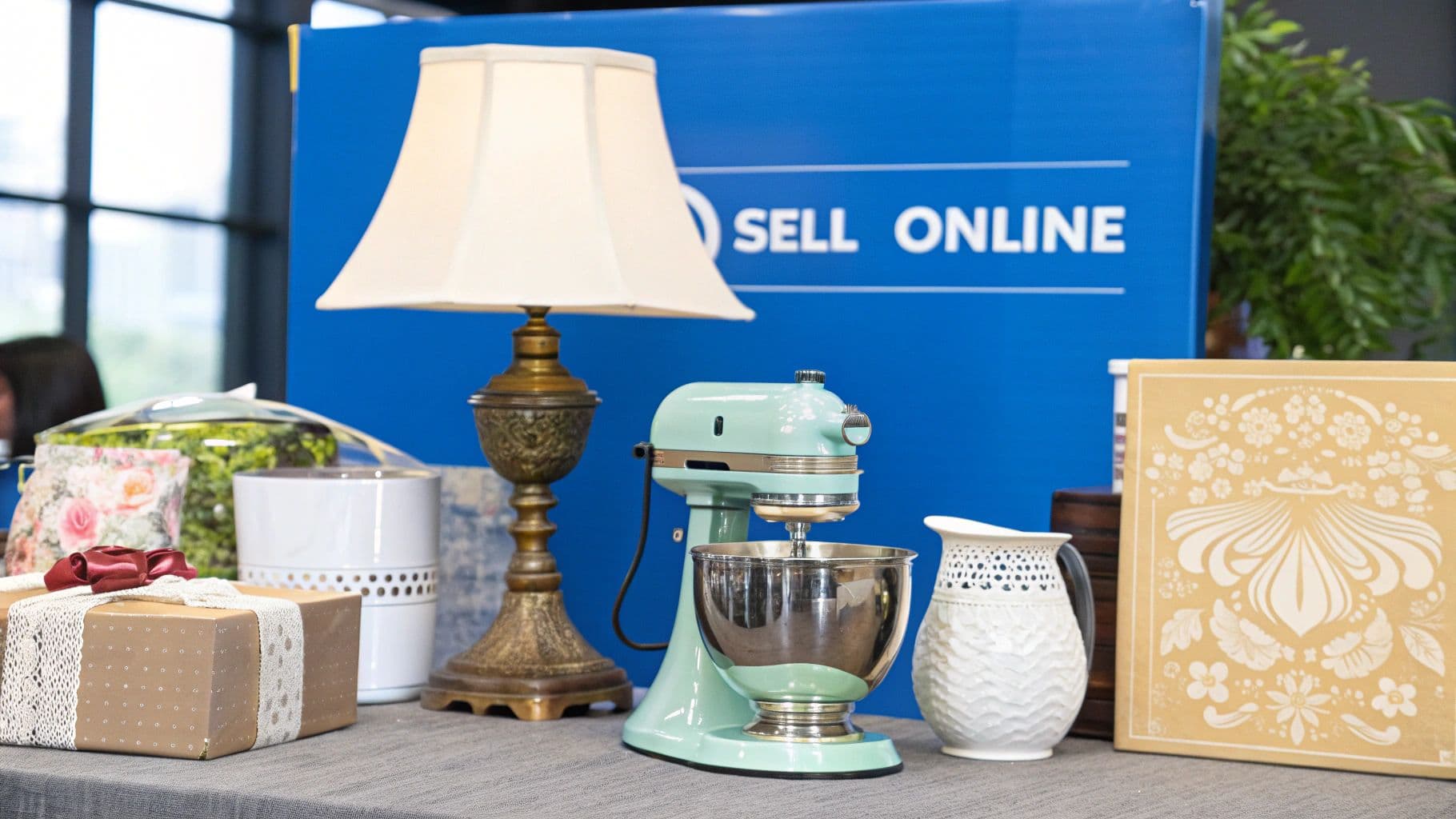
The best way to turn your unused goods into cash is by knowing what's valuable, taking great photos, and listing your stuff on a platform with a built-in audience of eager buyers. It’s a fantastic way to clear out some space and open up a new income stream at the same time.
Turning Your Clutter Into Cash
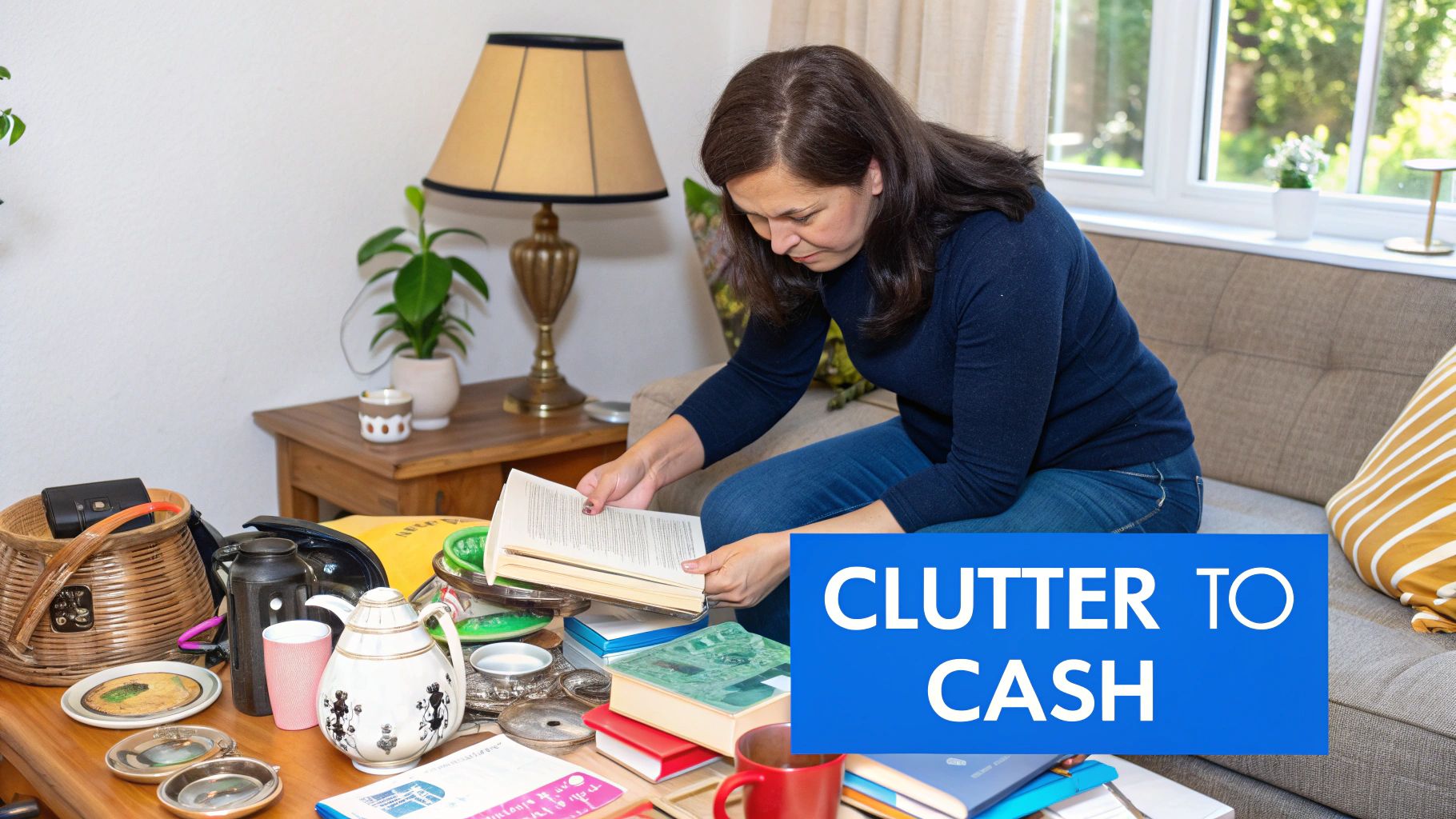
Welcome to the world of online selling. This is where your unwanted items can find a new home and, more importantly, put a little extra cash in your pocket. It's about more than just making space; this guide is all about the real financial and even environmental perks of selling what you no longer need.
The motivation is pretty simple: that forgotten armchair in the attic or the kitchen gadget still in its box is just untapped potential. This isn't just spring cleaning. It's about turning a chore into a profitable little project. With a platform like DIYAuctions, you get the tools to connect with a huge network of buyers, making the whole process easier than ever.
The Growing Opportunity to Sell Online
The online marketplace has absolutely exploded. By 2025, it's expected that 2.77 billion people will be shopping online—that's more than a third of the entire planet. This massive shift means there's a huge audience out there looking for exactly what you have, and household goods are always in demand.
This digital boom has created the perfect environment for you to sell household items online. People are actively searching for everything from secondhand furniture to unique collectibles, and they're completely comfortable buying from individual sellers just like you.
Identifying High-Value Items in Your Home
Okay, before you start listing anything, the first move is to figure out what you've got. Most people seriously underestimate the value of items they’ve had gathering dust for years. You’d be surprised what buyers are looking for.
Here are a few categories that almost always do well:
- Vintage Furniture: Think mid-century modern pieces, antique dressers, or unique chairs. These are always hot items.
- Brand-Name Kitchen Gadgets: KitchenAid mixers, Vitamix blenders, or high-end coffee machines sell great, even if they're gently used.
- Electronics: Old gaming consoles, quality speakers, or even vintage cameras can fetch a surprisingly good price.
- Collectibles: This is a huge category. It covers everything from rare books and vinyl records to action figures and antique dishware.
The real trick is to look at your items through a buyer's eyes. What story does this item tell? Is it a well-known brand? Does it solve a specific problem? Answering these questions helps you spot the hidden gems.
To Bundle or Not to Bundle
Once you've sorted through your stuff, you need a game plan. Should you sell that set of vintage plates one by one or as a complete bundle? Honestly, it depends on the items.
Bundling works best for things like:
- Complete Sets: Matched dishware, a collection of books by the same author, or a set of power tools.
- Lower-Value Items: Grouping small kitchen gadgets or kids' toys can make the listing more appealing and justify the shipping cost for a buyer.
Selling items individually is usually the right call for:
- High-Value Singles: A designer handbag, a rare collectible, or a single piece of valuable artwork.
- Items with Varied Demand: If you have a set of chairs but one is in perfect shape and another is a bit worn, selling them separately lets buyers pick and choose.
Thinking this through before you list anything sets you up for a much smoother sale. If you want to dive deeper, you might be interested in our guide on navigating a household items auction, which gets into more of these strategies. A little planning up front is what turns a pile of clutter into a well-organized, profitable inventory.
Photography That Makes Your Items Irresistible
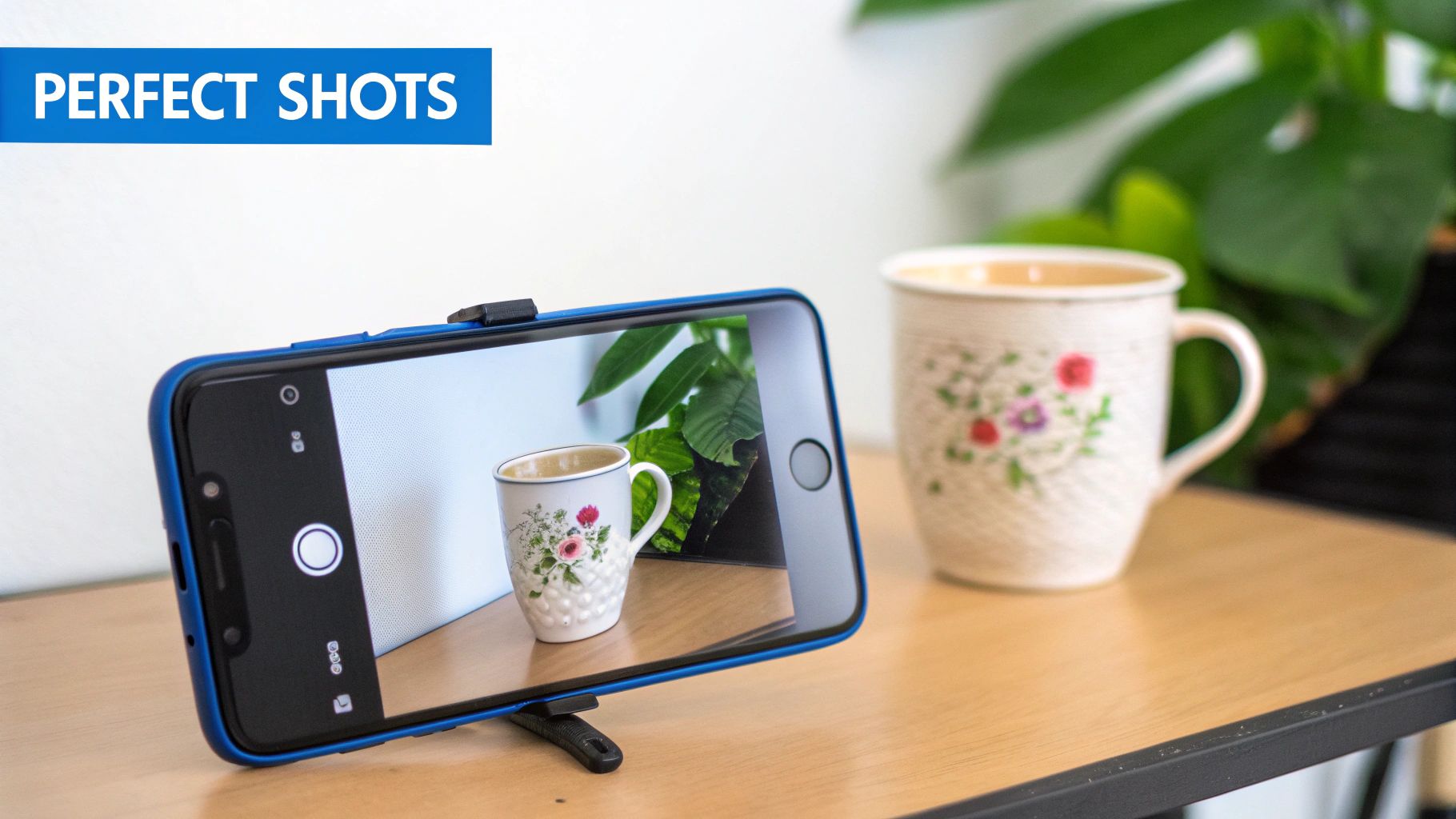
When you're selling things online, your photos are everything. They're your digital handshake, your storefront, and your number one salesperson, all rolled into one. Since buyers can’t pick up your items and inspect them, your pictures have to do all the heavy lifting to build trust and show value.
A blurry, dark photo can make a beautiful antique look like junk. But a crisp, well-lit shot? That can make a simple used chair feel like an absolute must-have find.
And no, you don't need a professional camera rig. The smartphone you have right now is more than powerful enough. The real magic isn't in the gear—it's in the prep work, the lighting, and telling a visual story that answers every question a buyer might have.
Prep Work Before the First Snap
Before you even touch your camera, get the item ready for its close-up. Spending just 10-15 minutes on this can make a huge difference in the final sale price and how quickly it sells. It signals to buyers that this item was well-cared-for, and that makes them feel much more confident placing a bid.
Start by giving it a good cleaning. Dust off that bookshelf, wipe down the microwave, and give any wood or metal a quick polish. If you're selling curtains or pillows, a trip through the laundry can work wonders to freshen them up.
Next, handle any easy fixes. A loose button, a wobbly table leg, a scuff you can buff out—take care of it now. Showing the item in its best possible light is always the goal.
Setting the Stage for the Perfect Shot
Once your item is looking its best, it's time to set up your "mini-studio." Don't worry, this is simpler than it sounds.
Find Your Light Source Natural light is your best friend. It’s free and it makes everything look better. Set up near a large window to get that soft, indirect daylight that makes colors look true and details pop. Try to avoid harsh, direct sun, which creates ugly shadows. Fun fact: a slightly overcast day is actually perfect for this.
Create a Clean Background You want your item to be the star of the show, not the laundry basket in the corner. A cluttered background screams "amateur" and distracts buyers.
- For smaller items: Grab a plain white poster board, a clean bedsheet, or even a roll of neutral-colored wrapping paper to create a simple, seamless backdrop.
- For larger furniture: Clear the space around it. Move away toys, stacks of mail, or anything else that pulls focus. A clean, plain wall is your best bet.
Your goal is a clean, intentional setting. It sends a powerful message to the buyer: "This item comes from a well-kept home." That unspoken signal builds a ton of trust and value.
Your Essential Shot List
To get top dollar, you need to show buyers everything. Think like a skeptic and capture all the angles they'd want to see if they were there in person. A complete set of photos means fewer questions in your inbox and more confident bidders.
Here’s the bare minimum you should capture for every item:
- The Hero Shot: A clear, straight-on photo of the entire item. This is your main listing image.
- Angle Shots: Get pictures from the back, both sides, the top, and even the bottom if relevant.
- Close-Up Details: Zoom in on interesting textures, brand logos, hardware, or unique features.
- Scale Shots: Show the item next to something familiar, like a coffee mug or a can of soda, to give an instant sense of its size. For furniture, show it in a room so people can visualize it in their own home.
- Flaw Shots: This is a big one. Be transparent. Take a clear, close-up photo of any scratch, dent, or sign of wear. This honesty builds massive trust and prevents any headaches or disputes after the sale.
For big pieces like sofas or dining sets, buyers often struggle to picture them in their own space. You can give them a helping hand with virtual staging AI tools that can digitally place your item in a stylish room setting. And if you really want to dive deep, check out our complete guide on how to take product photos at home for more pro tips.
Writing Listings That Actually Convert
You’ve got the photos. Now it’s time to write a description that works as your 24/7 salesperson. A great listing does more than just describe something; it convinces a potential buyer they’ve found exactly what they’re looking for. This is where you turn a simple post into a compelling sales pitch.
The words you choose build trust, answer questions before they're even asked, and make it easy for someone to go from just browsing to hitting that "buy" button. Think of it as telling the item's story—its features, its history, and yes, even its minor flaws. This honesty is what separates a listing that gets clicks from one that actually makes a sale.
Crafting the Perfect Listing Title
Your title is the first—and sometimes only—thing a buyer will see. It has to be searchable, informative, and straight to the point. The goal here is to load it with the keywords real people are typing into the DIYAuctions search bar when they want to sell household items online.
Forget cute or vague titles like "Awesome Blue Chair." You have to think like a buyer. What specific words would they use? A much better title would be "Vintage Mid-Century Modern Blue Velvet Armchair." See the difference?
Here’s a simple formula I always come back to:
- Brand Name: If it’s a known brand (like KitchenAid or Crate & Barrel), lead with that.
- Item Name: What is it, specifically? (e.g., Stand Mixer, Leather Sofa).
- Key Descriptors: Include style, color, or condition (e.g., Retro, Emerald Green, Like New).
- Model Number: If you have it, add it. A model number (like KSM150PSER) helps serious buyers find you instantly.
A strong title acts like a magnet, pulling in the right buyers who already know what they want. Spend a few extra minutes on this. It’s probably the single most important part of your listing’s visibility.
This infographic really breaks down the key parts of a listing that turns browsers into buyers.
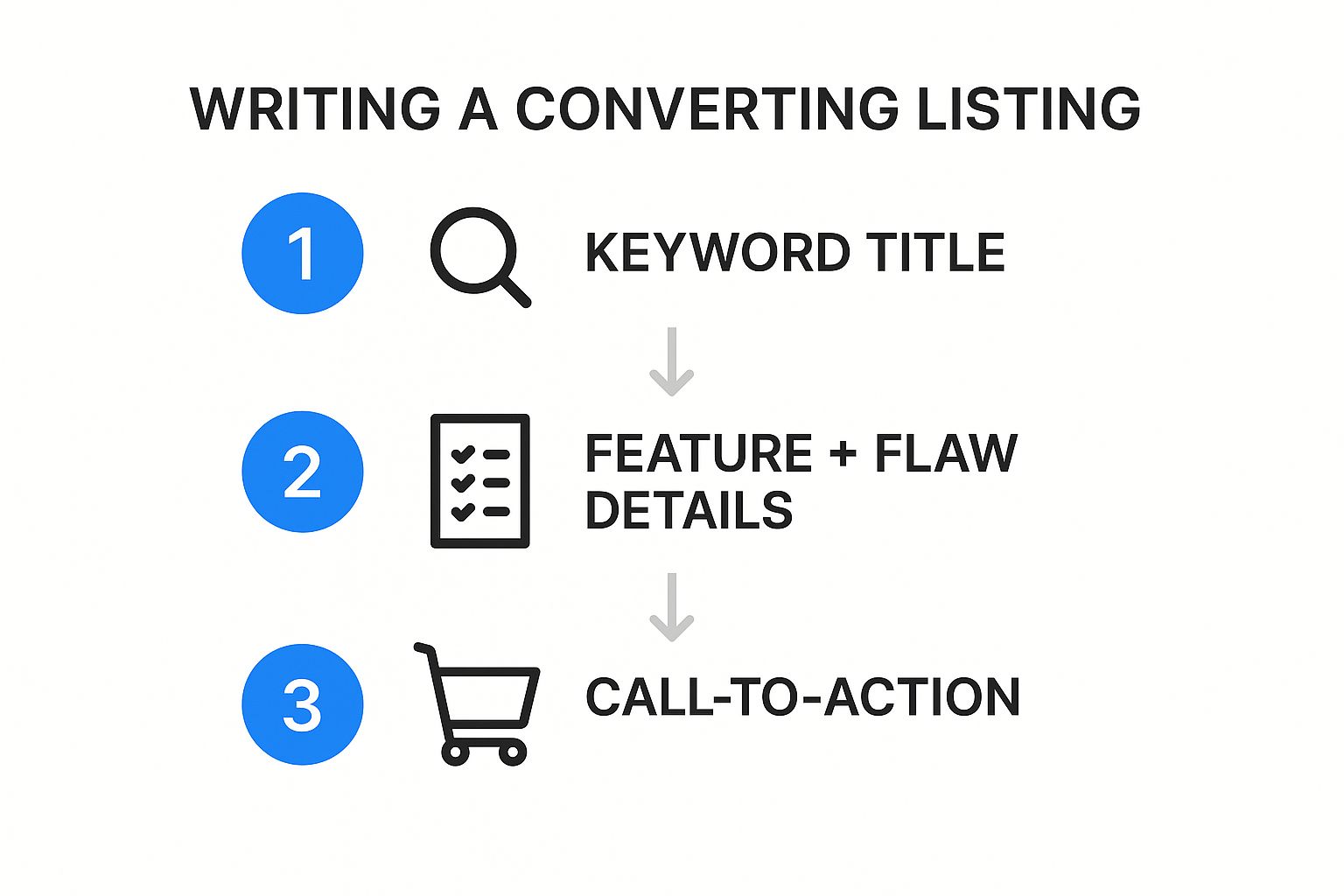 It shows how a keyword-rich title grabs attention, how the right details in the description build trust, and how a clear call to action closes the deal.
It shows how a keyword-rich title grabs attention, how the right details in the description build trust, and how a clear call to action closes the deal.
Writing Descriptions That Build Credibility
Once the title and photos have done their job, the description is where you seal the deal. Your best tool here is honesty. Of course you want to highlight an item's best features, but it's pointing out the flaws that truly builds credibility. People appreciate transparency, and it dramatically cuts down on the risk of a return or a dispute later.
Start by painting a picture for them. Instead of just saying "used lamp," try something more engaging. Maybe something like, "This vintage brass desk lamp has a warm, beautiful patina that looks fantastic in a home office. It’s fully functional and gives off great task lighting." For a deeper dive, there are some great resources on how to write compelling product descriptions that connect with people.
Next, get down to the nitty-gritty details. I like to use bullet points to make the key info easy to scan:
- Dimensions: Always include height, width, and depth. No excuses.
- Materials: Is it solid oak, genuine leather, or ceramic? Be specific.
- Condition: This is where you need to be brutally honest. Note every scratch, scuff, or ding. Something like, "Minor scratch on the left armrest (see photo #5)" is perfect.
- Story: If there's a cool story behind it, share it! Our guide on how to sell vintage items actually shows how a good story can increase what people are willing to pay.
This thorough approach shows you're a seller with nothing to hide. It also helps you stand out in the massive world of e-commerce. It's projected that online marketplaces will account for 63.5% of all online sales in 2025, giving you access to billions of potential customers. Your detailed, honest listing is what will make you the seller they choose.
Pricing and Shipping Without The Headaches
Figuring out what your stuff is worth and how to get it to a buyer can feel like the biggest hurdles to overcome. It’s where a lot of people get stuck.
Price your items too high, and you'll hear crickets. Price them too low, and you're just leaving cash on the table. The same goes for shipping—one wrong calculation can completely erase your profit. Let's break down how to handle both like a seasoned pro.
Finding The Sweet Spot for Your Price
Forget guesswork. The only way to know what your item is really worth is to see what people have actually paid for it recently. That vintage Pyrex bowl might have a dozen listings for $100, but if the last five sales were all around $60, then $60 is your real-world number.
This is where DIYAuctions makes your life easier. Search for items just like yours, but here’s the key: filter the results to show only “Sold” or “Completed” listings. This simple click shows you what buyers are willing to pay, not just what sellers are asking.
When you're looking at those sold listings, put on your detective hat and notice the little things:
- Condition: Was the item that sold in mint condition, or did it have a few scratches? Be honest about your own item and adjust the price accordingly.
- Completeness: Did the sold item come with the original box or all its accessories? Those extras often justify a higher selling price.
- Listing Quality: A great set of photos and a detailed, well-written description can often fetch a premium over a listing that looks rushed.
Don’t hang your hat on just one or two sales. Try to find an average from at least five to ten recent sales to get a truly accurate read on the market. This little bit of data-driven homework removes all the pricing anxiety.
Auction vs. Buy It Now: Which Is Right for You?
DIYAuctions gives you a couple of ways to sell, and the best choice really depends on what you have.
An auction-style listing is your best friend for items that are rare, in high demand, or just plain unique. Think collectibles, a hard-to-find piece of vintage clothing, or a cool piece of mid-century furniture. The competitive nature of an auction can create a real buzz, sometimes pushing the final price way past what you ever expected. It's a fantastic way to let the market tell you what something is worth.
A Buy It Now (fixed-price) listing, on the other hand, is perfect for more common items with a well-known value. If you know your specific model of Cuisinart food processor has been consistently selling for around $75, a fixed price is clean and simple. Buyers who know what they want can grab it instantly without waiting around.
Conquering The Shipping Challenge
This is the part that trips up so many new sellers. But here’s the secret: figure out your shipping costs before you even create your listing.
You only need two simple tools to get started: a basic postage scale and a measuring tape. You absolutely cannot guess these numbers. Pack your item up securely in its box with plenty of padding, and then weigh and measure it. The final packed dimensions and weight are what the carriers care about.
You don't need to spend a fortune on supplies, either.
- Boxes: Just save them from your own online shopping. You can also ask friends or check local "Buy Nothing" groups—people are often thrilled to get rid of moving boxes.
- Padding: Old newspapers, bubble wrap from other packages, or even balled-up plastic grocery bags work great for cushioning. Just make sure the item can't rattle around inside the box.
Once you have your final numbers, it's time to find the best rate.
Shipping Carrier Comparison for Common Household Items
Choosing the right shipping carrier can save you a surprising amount of money. Here’s a quick rundown of who’s best for what when you’re shipping from within the US.
| Item Type (Example) | Best Carrier (USPS/UPS/FedEx) | Estimated Cost Range | Best For |
|---|---|---|---|
| Small Collectible (Mug) | USPS | $5 - $10 | Items under 1 lb; offers the cheapest rates for light packages via Ground Advantage. |
| Set of Books (5 lbs) | USPS | $8 - $15 | Media Mail is an incredibly cheap (but slow) option for books and other media. |
| Kitchen Appliance (Blender) | UPS | $15 - $25 | Often more competitive than others for packages between 2-20 lbs. Great tracking. |
| Small Furniture (End Table) | FedEx / UPS | $30 - $70+ | Best for larger, heavier, or awkwardly shaped items. Compare rates directly. |
You can use the online shipping calculators from USPS, UPS, and FedEx to get an exact quote for your package.
Taking a few minutes to do this research upfront ensures that a surprise postage bill doesn't turn your successful sale into a money-losing headache.
Managing Your Sale and Ensuring a Smooth Transaction
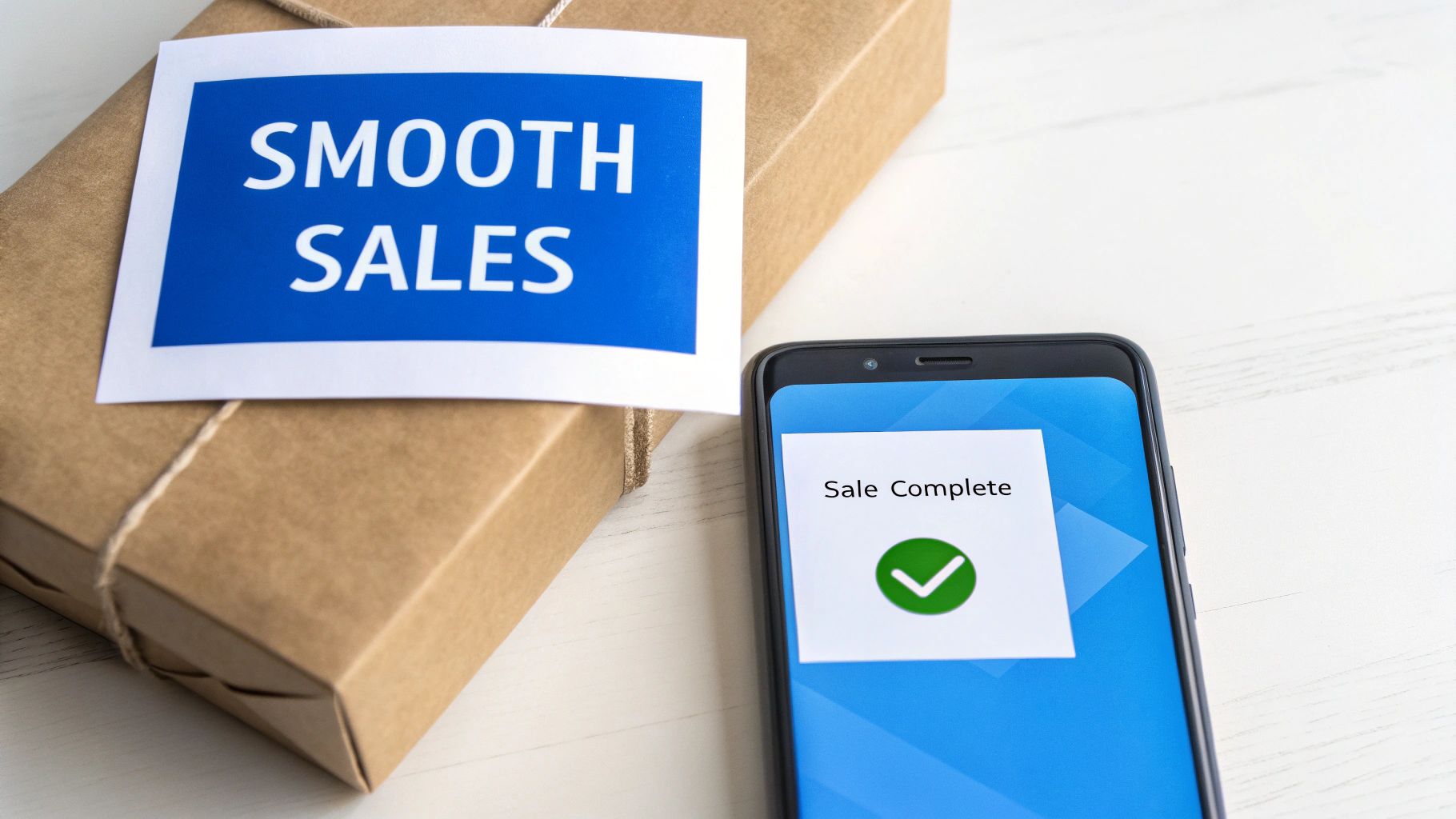
Getting your item listed is a great first step, but the real work begins after you hit "publish." This is where the best sellers really shine. Great post-sale management and customer service are what build a reputation and turn a one-time buyer into someone who leaves you glowing reviews.
Think of this as the active phase of your sale. When you sell household items online, you’re doing more than just moving inventory; you're building trust with every single interaction.
Mastering Buyer Communication
Prompt, friendly communication is your secret weapon once your listing is live. If a potential buyer messages you asking about an item’s dimensions, they're seriously interested. A slow or unhelpful response might just send them clicking over to another seller.
I always tell new sellers to set up notifications for their DIYAuctions messages. Try to respond within a few hours. That kind of speed shows buyers you’re a professional they can count on.
When it comes to offers, be polite but clear. If an offer comes in too low, a simple counteroffer and a message like, "Thanks for your interest! I can't go that low, but I could do [Your Counteroffer Price]" keeps the door open and often seals the deal.
Your communication sets the tone for the entire transaction. A positive, helpful, and quick response not only answers questions but also builds the confidence a buyer needs to commit to the purchase.
The world of e-commerce is only getting bigger. By 2025, the number of online shoppers is expected to reach 2.77 billion, with online sales making up 21% of all retail purchases. That massive customer base is looking for the convenience and great service that smart sellers like you can provide. You can find more insights on the rise of global e-commerce on sellerscommerce.com.
From Sold to Shipped Seamlessly
Congrats, your item sold! Now it’s time to stick the landing. Fulfilling the order quickly and correctly is how you earn that coveted positive feedback.
Secure Packaging is Non-Negotiable Your top priority is making sure the item arrives in the same condition you described. Use a sturdy box, plenty of bubble wrap or crumpled paper, and give it a little shake to ensure nothing moves around. For anything really fragile, I always double-box it—put the item in a smaller padded box, then place that inside a larger one with even more cushioning.
Streamline Your Shipping Process DIYAuctions makes this part a breeze. You can print shipping labels right from your seller dashboard. It automatically fills in the buyer’s address and tracking info, which saves a ton of time and prevents typos.
Proactive Tracking Communication Once the package is on its way, shoot the buyer a quick message. Something simple like, "Hi [Buyer's Name], just wanted to let you know your item is on its way! The tracking number is [Tracking Number]. Thanks again!" This little update provides peace of mind and makes for a great customer experience.
Handling Potential Issues Gracefully
Even the most careful sellers run into hiccups now and then. How you deal with them is what truly defines your reputation.
- Non-Paying Bidders: It happens. DIYAuctions has a clear process for reporting a non-paying buyer so you can get your fees back and relist the item without much hassle.
- Return Requests: First, check your own return policy. If a buyer has a valid reason for a return—like the item was damaged in shipping—handle it like a pro. Apologize for the trouble and clearly explain the next steps for the return and refund.
Managing these moments with a cool head protects your seller rating and shows other potential buyers you’re a trustworthy person to do business with.
Common Questions About Selling Used Items Online
Jumping into the world of online selling always brings up a few questions. I've seen it time and time again. People wonder what items actually move quickly, or they get nervous thinking about how to ship that bulky armchair sitting in the corner. Everyone starts with similar hurdles.
Let's clear those up with some direct, practical answers so you can start listing and selling with confidence.
What Household Items Consistently Sell Best?
While fads come and go, some categories of used goods are always in demand. People are on the lookout for quality, value, and things that have a bit of character or a solid purpose. If you're wondering where to start, focusing on these will give you the best shot at a quick sale.
From my experience, these are the most reliable sellers:
- Brand-Name Kitchenware: Think about brands like KitchenAid, Le Creuset, or even quality stuff from Crate & Barrel. People trust the names, so these pieces hold their value incredibly well, even when they're gently used.
- Solid Wood Furniture: In a world filled with particleboard, real wood is king. Anything from a small end table to a full dining set is highly sought after because it's built to last and has a timeless look.
- Electronics in Good Working Condition: You might be surprised. It's not just about the latest models. Older gaming consoles, quality stereo equipment from the 80s or 90s, and unique vintage gadgets have dedicated fan bases.
- Unique Decor and Collectibles: This is where things get fun. Vintage art, interesting pottery, antique lamps, and even old vinyl records will attract passionate buyers who are hunting for something with a story.
How Do I Handle Shipping for Large or Fragile Items?
Shipping is easily the biggest headache for new sellers, especially when you're dealing with something heavy, awkwardly shaped, or delicate. But it doesn't have to be. The key is to plan ahead so you don't watch your profit get eaten up by postage.
First thing's first: never guess the weight or dimensions. Pack the item completely—box, bubble wrap, tape, everything—then weigh and measure it. This gives you the exact numbers you need for an accurate shipping quote. For anything fragile like glassware or ceramics, use the double-boxing method. Wrap the item well, put it in a small, snug box, then float that box inside a larger one with plenty of cushioning.
For the big stuff like small furniture, FedEx Home Delivery or UPS Ground are usually your best bet. They’re set up to handle heavier packages and give you solid tracking.
A quick pro tip: You can (and should) pass the exact shipping cost on to the buyer. When you're listing on DIYAuctions, just use the calculated shipping option. It shows the buyer the real-time cost based on their location. It's the fairest and most transparent way to do it.
What Is the Best Way to Deal with Difficult Buyers?
Look, the vast majority of people you'll deal with are great. But every now and then, you might run into someone who's a bit challenging. The best approach is always to stay professional, keep calm, and stick to the facts you laid out in your listing.
If a buyer starts peppering you with questions that are clearly answered in your description, just politely point them back to it. A simple, "Thanks for your interest! The full dimensions are listed in the 'Details' section of the listing," works perfectly. It’s efficient and keeps things professional.
What if a complaint or return request comes in? Your first move is to go back and review your original listing and photos. If you were honest about that scratch on the table, you can stand by your description with confidence. If there’s a legitimate issue, like something got damaged in transit, just work with the buyer and DIYAuctions to find a fair solution. Your reputation is built on how you handle these moments, so a courteous tone is everything.
How Can I Stay Organized with Multiple Listings?
Once you start selling more than one or two things at a time, you absolutely need a simple system to keep track of it all. Good organization is what prevents you from shipping the wrong item to the wrong person and makes the whole process feel manageable instead of chaotic.
A basic spreadsheet is your best friend here. Seriously. Create a few columns: item name, listing date, final sale price, buyer's name, and tracking number. The second an item sells and you ship it, pop the tracking info in there. Now you have a central command center for all your sales.
It also helps to get organized physically. Find a specific spot in your home for all your listed items. Some sellers I know even print out a small label with the listing number and tape it to the item or its box. It’s a tiny step, but it guarantees that when your vintage lamp sells, you grab and ship the correct vintage lamp.